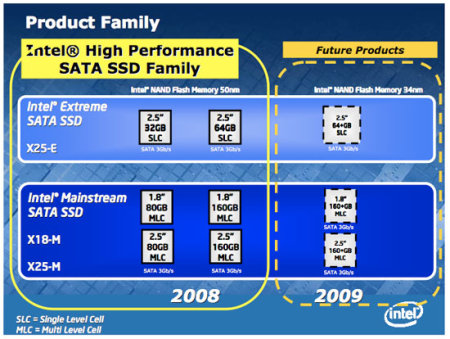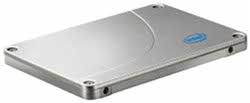Intel cuts SSD pricing, adds midrange model
Nov 12, 2010 — by LinuxDevices Staff — from the LinuxDevices Archive — viewsIntel has cut the price of its 2.5-inch SSDs (solid state disks), aimed primarily at PC enthusiasts but also applicable to embedded devices. The company has also added a new version of the X25-M, which — at a list price of $250 for 120GB — is said to offer consumers the best dollar-per-gigabyte value.
The Intel price cuts are an example of the SSD's steady (but fairly slow) move into mainstream computing. The chipmaker's first X25-M drive made its debut in 2008 using MLC (multi-level cell) flash technology manufactured using a 50nm process.
Priced at nearly $600 for 80GB of storage, the 2.5-inch, SATA-interfaced drive became cheaper and faster last year when Intel moved to 34nm manufacturing. At that point, the 80GB SSD device gained a list price of $270, plus sustained read/write ratings of 250MB/sec. and 70MB/sec., respectively.

Intel's 34nm SSDs were first disclosed on this 2008 roadmap
Source: Intel
(Click to enlarge)
Now, says Intel, the 80GB SSD has been cut in price still further, to approximately $200. In addition, the chipmaker adds, there are now two other X-25M models: a 160GB version that costs $415 and a 120GB version that costs $250.
Intel notes that the 120GB X-25M offers the best dollar-per-gigabyte value in its SSD product line. Compared to the earlier 80GB product, the 120GB and 160GB versions also get a faster 100MB/sec. write speed, the company adds.
 Intel also announced a price cut for a smaller, slower SDD it describes as "perfect for value segment netbooks and dual-drive desktop setups." First introduced in March but now list-priced at just $100, the X25-V (right) has a specified read speed of 170MB/sec. and a write speed of 35MB/sec.
Intel also announced a price cut for a smaller, slower SDD it describes as "perfect for value segment netbooks and dual-drive desktop setups." First introduced in March but now list-priced at just $100, the X25-V (right) has a specified read speed of 170MB/sec. and a write speed of 35MB/sec.
The above figures make the entry-level device rather slow for an SSD. However, as Intel points out, the X25-V's performance is nearly four times faster than a 7200RPM hard disk drive. Offering a 1.2 million hour MTBF, the device is touted as particularly suitable for dual-drive desktop installations, whose enthusiast owners would install the SSD as a boot disk and retain their previous hard disk drives for other storage needs.
For example, the company claims, a user could load the 40GB SSD with the Windows 7 operating system, Microsoft Office applications, and a favorite gaming application such as "Dragon Age: Origins," experiencing up to 43 percent faster overall system performance or 86 percent improvement in their gaming experience. The SSD would speed operations such as system startup, the opening of applications and files, or resuming from standby, adds Intel.
Keeping Trim
All the Intel drives are said to support the Trim command functionality in Windows 7, whereby the operating system can tell a card which data blocks are no longer in use. Much quicker than an erase operation, a trim command merely removes stale data — that which had already been marked as deleted by the operating system — from a drive's internal allocation list.
Troy Winslow, director of product marketing for Intel's NAND solutions group, stated, "With prices dropping, the solid-state drive is becoming more mainstream and can make the single greatest improvement to PC performance. With an SSD, tech shoppers can give the gift of a technology makeover that will help speed up, or breathe new life, into a current PC by just swapping out the hard drive for an SSD."
A promotional video for the new 120GB X25-M
(click to play)
Further information
More information about Intel's X25-M range and the X25-V may be found on the company's website, here and here, respectively.
This article was originally published on LinuxDevices.com and has been donated to the open source community by QuinStreet Inc. Please visit LinuxToday.com for up-to-date news and articles about Linux and open source.